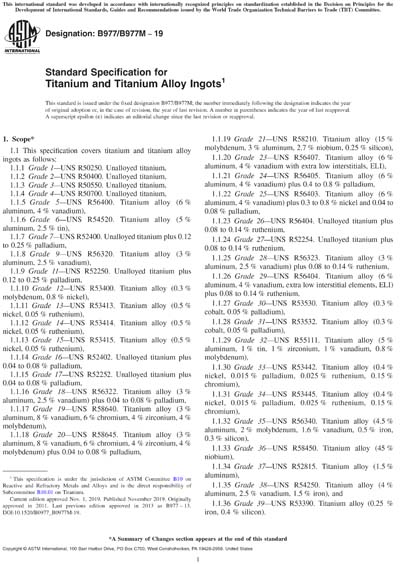Most recent
ASTM B977/B977M-19
Standard Specification for Titanium and Titanium Alloy Ingots
1.1 This specification covers titanium and titanium alloy ingots as follows:
1.1.1 Grade 1—UNS R50250. Unalloyed titanium,
1.1.2 Grade 2—UNS R50400. Unalloyed titanium,
1.1.3 Grade 3—UNS R50550. Unalloyed titanium,
1.1.4 Grade 4—UNS R50700. Unalloyed titanium,
1.1.5 Grade 5—UNS R56400. Titanium alloy (6 % aluminum, 4 % vanadium),
1.1.6 Grade 6—UNS R54520. Titanium alloy (5 % aluminum, 2.5 % tin),
1.1.7 Grade 7—UNS R52400. Unalloyed titanium plus 0.12 to 0.25 % palladium,
1.1.8 Grade 9—UNS R56320. Titanium alloy (3 % aluminum, 2.5 % vanadium),
1.1.9 Grade 11—UNS R52250. Unalloyed titanium plus 0.12 to 0.25 % palladium,
1.1.10 Grade 12—UNS R53400. Titanium alloy (0.3 % molybdenum, 0.8 % nickel),
1.1.11 Grade 13—UNS R53413. Titanium alloy (0.5 % nickel, 0.05 % ruthenium),
1.1.12 Grade 14—UNS R53414. Titanium alloy (0.5 % nickel, 0.05 % ruthenium),
1.1.13 Grade 15—UNS R53415. Titanium alloy (0.5 % nickel, 0.05 % ruthenium),
1.1.14 Grade 16—UNS R52402. Unalloyed titanium plus 0.04 to 0.08 % palladium,
1.1.15 Grade 17—UNS R52252. Unalloyed titanium plus 0.04 to 0.08 % palladium,
1.1.16 Grade 18—UNS R56322. Titanium alloy (3 % aluminum, 2.5 % vanadium) plus 0.04 to 0.08 % palladium,
1.1.17 Grade 19—UNS R58640. Titanium alloy (3 % aluminum, 8 % vanadium, 6 % chromium, 4 % zirconium, 4 % molybdenum),
1.1.18 Grade 20—UNS R58645. Titanium alloy (3 % aluminum, 8 % vanadium, 6 % chromium, 4 % zirconium, 4 % molybdenum) plus 0.04 to 0.08 % palladium,
1.1.19 Grade 21—UNS R58210. Titanium alloy (15 % molybdenum, 3 % aluminum, 2.7 % niobium, 0.25 % silicon),
1.1.20 Grade 23—UNS R56407. Titanium alloy (6 % aluminum, 4 % vanadium with extra low interstitials, ELI),
1.1.21 Grade 24—UNS R56405. Titanium alloy (6 % aluminum, 4 % vanadium) plus 0.4 to 0.8 % palladium,
1.1.22 Grade 25—UNS R56403. Titanium alloy (6 % aluminum, 4 % vanadium) plus 0.3 to 0.8 % nickel and 0.04 to 0.08 % palladium,
1.1.23 Grade 26—UNS R56404. Unalloyed titanium plus 0.08 to 0.14 % ruthenium,
1.1.24 Grade 27—UNS R52254. Unalloyed titanium plus 0.08 to 0.14 % ruthenium,
1.1.25 Grade 28—UNS R56323. Titanium alloy (3 % aluminum, 2.5 % vanadium) plus 0.08 to 0.14 % ruthenium,
1.1.26 Grade 29—UNS R56404. Titanium alloy (6 % aluminum, 4 % vanadium, extra low interstitial elements, ELI) plus 0.08 to 0.14 % ruthenium,
1.1.27 Grade 30—UNS R53530. Titanium alloy (0.3 % cobalt, 0.05 % palladium),
1.1.28 Grade 31—UNS R53532. Titanium alloy (0.3 % cobalt, 0.05 % palladium),
1.1.29 Grade 32—UNS R55111. Titanium alloy (5 % aluminum, 1 % tin, 1 % zirconium, 1 % vanadium, 0.8 % molybdenum),
1.1.30 Grade 33—UNS R53442. Titanium alloy (0.4 % nickel, 0.015 % palladium, 0.025 % ruthenium, 0.15 % chromium),
1.1.31 Grade 34—UNS R53445. Titanium alloy (0.4 % nickel, 0.015 % palladium, 0.025 % ruthenium, 0.15 % chromium),
1.1.32 Grade 35—UNS R56340. Titanium alloy (4.5 % aluminum, 2 % molybdenum, 1.6 % vanadium, 0.5 % iron, 0.3 % silicon),
1.1.33 Grade 36—UNS R58450. Titanium alloy (45 % niobium),
1.1.34 Grade 37—UNS R52815. Titanium alloy (1.5 % aluminum),
1.1.35 Grade 38—UNS R54250. Titanium alloy (4 % aluminum, 2.5 % vanadium, 1.5 % iron), and
1.1.36 Grade 39—UNS R53390. Titanium alloy (0.25 % iron, 0.4 % silicon).
1.2 The values stated in either SI units or inch-pound units are to be regarded separately as standard. The values stated in each system may not be exact equivalents; therefore, each system shall be used independently of the other. Combining values from the two systems may result in non-conformance with the standard.
1.3 The following caveat pertains only to the test method portions of this specification: This standard does not purport to address all of the safety concerns, if any, associated with its use. It is the responsibility of the user of this standard to establish appropriate safety, health, and environmental practices and determine the applicability of regulatory limitations prior to use.
1.4 This international standard was developed in accordance with internationally recognized principles on standardization established in the Decision on Principles for the Development of International Standards, Guides and Recommendations issued by the World Trade Organization Technical Barriers to Trade (TBT) Committee.
Content Provider
ASTM International [astm]






